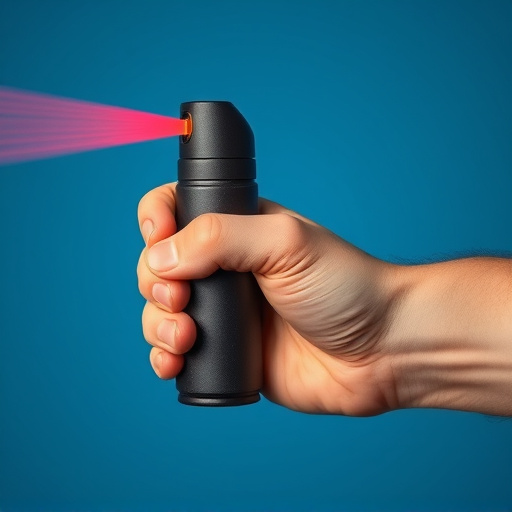The defensive pepper spray distance range (2-5 meters) is critical for its effectiveness as a riot control and personal defense tool. Understanding brand-specific ranges, proper usage techniques like aiming at faces and eyes, and environmental factors such as wind and humidity are key to maximizing its potential while minimizing risks during civil unrest or violent encounters. Effective deployment within 2-3 meters ensures safety for both law enforcement and citizens.
In the face of escalating civil unrest, law enforcement agencies worldwide are increasingly turning to inflammatory spray, or defensive pepper spray, as a crucial tool for riot control. This potent chemical agent can rapidly disrupt and disperse crowds, offering a critical layer of protection for both officers and citizens. Understanding how this spray works, its effects, and the factors affecting its defensive pepper spray distance range is essential for effective deployment in high-pressure situations.
- Understanding Inflammatory Spray for Riot Control
- How Defensive Pepper Spray Works and Its Effects
- Factors Affecting the Distance Range of Spray
- Best Practices and Safety Measures When Using Pepper Spray in Riot Situations
Understanding Inflammatory Spray for Riot Control
Inflammatory spray, often referred to as defensive pepper spray, is a powerful tool used for riot control and personal defense. It’s designed to incapacitate individuals by causing temporary blindness, coughing, and difficulty breathing when sprayed directly into the face. The active ingredient in these sprays, capsaicin, is derived from chili peppers and creates an intense irritation response in the body.
Understanding the defensive pepper spray distance range is crucial for effective deployment. These sprays typically have a reach of around 3 to 5 meters (10-16 feet), allowing users to maintain a safe distance while neutralizing potential threats. The distance range varies between different brands and models, with some specialized riot control sprays offering even greater reach. Knowing the spray’s effective range ensures that it can be used optimally in high-pressure situations, providing an extra layer of safety for both law enforcement officers and citizens during civil unrest or violent encounters.
How Defensive Pepper Spray Works and Its Effects
Defensive pepper spray is a non-lethal weapon designed to disable and disrupt aggressive individuals during law enforcement operations or civil unrest. Its primary active ingredient, capsaicin, is derived from chili peppers and is known for its irritant properties. When sprayed, capsaicin comes into contact with the eyes, nose, mouth, and skin, triggering a series of physiological responses. The most immediate effect is a burning sensation, leading to temporary blindness and reduced visibility within the defensive pepper spray distance range (typically around 2-4 meters). This impairment significantly impedes an attacker’s ability to coordinate attacks and escape.
Beyond visual disruption, capsaicin causes excessive sweating and respiratory distress due to the body’s attempt to cool down and expel the irritant. These effects can last for several minutes, providing enough time for the target to subside or for law enforcement to intervene. However, it’s important to note that defensive pepper spray is not without risks; it can also affect bystanders if misused or deployed in enclosed spaces, necessitating careful handling and adherence to specific deployment protocols.
Factors Affecting the Distance Range of Spray
Several factors determine the distance range of defensive pepper spray during riot control. One primary factor is the concentration and potency of the capsaicinoid active ingredient in the spray. Higher concentrations can achieve greater reach, affecting both visibility and respiratory function over a longer area. The pressure at which the spray is dispensed also plays a crucial role; higher pressure increases the distance the spray particles can travel, enhancing its effectiveness in crowd control scenarios.
The environment itself significantly influences the defensive pepper spray’s range. Outdoor conditions, such as wind speed and direction, can carry the spray for longer distances compared to enclosed spaces like buildings or tight alleyways. Surface roughness and atmospheric humidity also impact spray dispersion; turbulent air movements and higher humidity tend to reduce the effective reach. Understanding these variables is essential for optimal deployment strategies in riot control situations.
Best Practices and Safety Measures When Using Pepper Spray in Riot Situations
When employing defensive pepper spray in riot control, adhering to best practices and safety measures is paramount. It’s crucial to understand the defensive pepper spray distance range – typically around 2-3 meters (6-10 feet) – to ensure effective deployment without posing risks to nearby civilians or enforcement officers. This precise application involves aiming for the face and eyes, as pepper spray irritates these sensitive areas, temporarily incapacitating individuals.
Training is essential for officers using pepper spray in riot situations. Regular practice sessions help them master proper usage techniques, ensuring the spray is deployed accurately and safely. Officers must also be equipped with appropriate protective gear, including eye protection, to shield themselves from potential cross-contamination. Additionally, having a clear de-escalation strategy in place before resorting to pepper spray can help prevent its misuse, fostering safer riot control outcomes.
Inflammatory spray, particularly defensive pepper spray, plays a significant role in riot control by providing a non-lethal means of dispersing crowds. Understanding how this spray works and the factors influencing its distance range is crucial for law enforcement to ensure effective deployment while maintaining safety measures. By adhering to best practices, authorities can maximize the defensive pepper spray distance range and minimize potential harm, making it an indispensable tool in managing chaotic situations.
